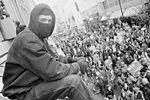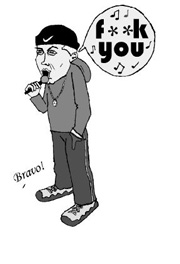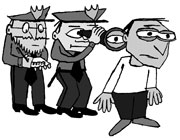TUESDAY, NOVEMBER 30, 1999 will forever be the day the WTO stood still. Regardless of what happens the rest of the week, on one magical day a few thousand nonviolent protesters, many under the age of 25, managed to bring the most powerful organization in the world to a standstill. They succeeded despite months of preparation by the Seattle Police Department and a host of other local, state, and federal agencies. How did it happen?
The strategy of the Direct Action Network—which also spent months planning for “N30″—was relatively simple. Protest organizers targeted the Paramount Theatre—where WTO activities were scheduled to start—and divided the surrounding area into 13 wedges. Different affinity groups—of 5-15 people, many willing to risk arrest—took responsibility for blocking key intersections and hotels in each wedge. Organizers assumed they would not be able to get near the Paramount itself, and so sought to gridlock downtown, preventing delegates in their limos, cabs, and even motel rooms from getting to their appointed talks.
The strategy succeeded beyond DAN’s wildest expectations, for two important reasons. First, a flood of protesters were willing to brave 7am rains to shut the WTO down. Optimistic organizers had hoped for a thousand, maybe two, on the morning streets of downtown Seattle. By the end of the day they were estimating that 10,000 had joined the protests—excluding the big AFL-CIO march. The early signs were there: For two weeks prior to the protest, people flooded the Denny Way “Welcome Center” DAN set up to orient incoming protesters, and Sunday evening nonviolence trainings drew 100 people. Clearly, it was going to be big. The police had no idea.
The affinity groups spent the whole day on Tuesday blocking their intersections, untouched by police. While craziness erupted around them—tear gas and rubber bullets from the police, broken windows and dumpster fires from hooligans—the affinity groups stood their ground, holding intersections by linking arms, locking down, or (in one case on Boren Avenue) erecting a massive tripod of the sort used in forest blockades.
The second factor was what can only be construed as a massive miscalculation by police. In ringing Metro buses and police lines to protect the Paramount and Convention Center, they forgot to leave a way for delegates to get in. Or out.
The US trade representative, Charlene Barshefsky, was unable, despite the massive police presence, to get one block from her hotel room to opening sessions. It would have been simple enough for police to provide a corridor from hotels to the meeting place, but that never happened. Thousands of protesters were barring the way, and when the twin marches of protesters from Victor Steinbrueck Park and Seattle Central Community College got to the neighborhood at 7:30 in the morning, no police were there to prevent them from seizing intersections. Indeed, throughout the morning police were completely outnumbered by protesters.
The people, quite simply, spoke. A wide fusion of radical environmentalists, labor activists, human rights advocates, and social justice workers made the WTO listen when for five years it had adamantly refused. The terms of the free trade debate have forever been changed; no amount of tear gas or police harassment of demonstrators after the fact changed that bottom line. For one day, a ragtag army of nonviolent global citizens spoke—and the world listened.







